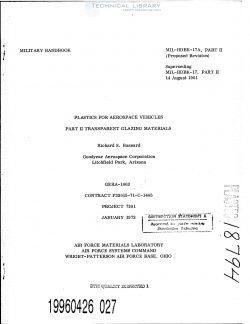MIL-HDBK-17A-P2
- Version
- 1065 Downloads
- 15.28 MB File Size
- 1 File Count
- March 5, 2017 Create Date
- March 5, 2017 Last Updated
Plastics for Aerospace Vehicles - Part II - Transparent Glazing Materials

This handbook has been prepared for the Air Force to provide information for the selection of transparent glazing materials and the factors to be considered in their installation and use in military aircraft. In the last decade, aircraft glazing configurations have become incrcasingly complex, to the extent of not only performing as structural members but also as protective coverings in a wide variety of situations. Structural loading in the flight profiles Of high-performance aircraft involves not only differentials between cockpit pressurization and outer ram air loading, but also transient thermal conditions that tax the lower extremities of material strength spectrums. Adding the protective features usually increases the transparency thickness and weight beyond that required for structural integrity. If a special coating is required, an additional transparent coating or sheet is often necessary to protect the active coating from damage. In situations where differences of thermal expansion coefficients are critical between two rigid materials, a separating elastic interlayer is added as a further complexity. With one exception, any of the additional protective features will act negatively toward light trans— mission and optical integrity. The design engineer has to carefully evaluate the structural and protective requirements of the aircraft transparency, keeping in mind that the final design must meet certain optical requirements which can be very critical in areas used for landing or gun—sighting operations and less critical in general viewing areas.
The data on the mechanical, thermal, optical, and other properties of transparent plastics and glass have been selected from a number of specifications and reports. Sufficient test data were not available on all materials for establishing design allowables. Therefore, some material property data are only representative values and should be considered as such. Because most configurations are complex, the designer should prepare test specimens of the final design configuration and conduct confirmation tests of all critical design factors. The format essentially starts with materials and sources available for transparent enclosures and includes both glazing and supplementary materials for the design and manufacture of composite constructions. considerations follow which concern allowable strength values and a discussion of some of the more critical properties that influence desi*l. The majority of the technical data is presented in Chapter 4, which treats each type of monolithic transparent sheet as a separate entity and is grouped in two parts, Mth military specified materials divided from those which are being considered for aircraft use.
| File | Action |
|---|---|
| MIL-HDBK-17A-P2 Plastics for Aerospace Vehicles - Part II - Transparent Glazing Materials.pdf | Download |

Comment On This Post